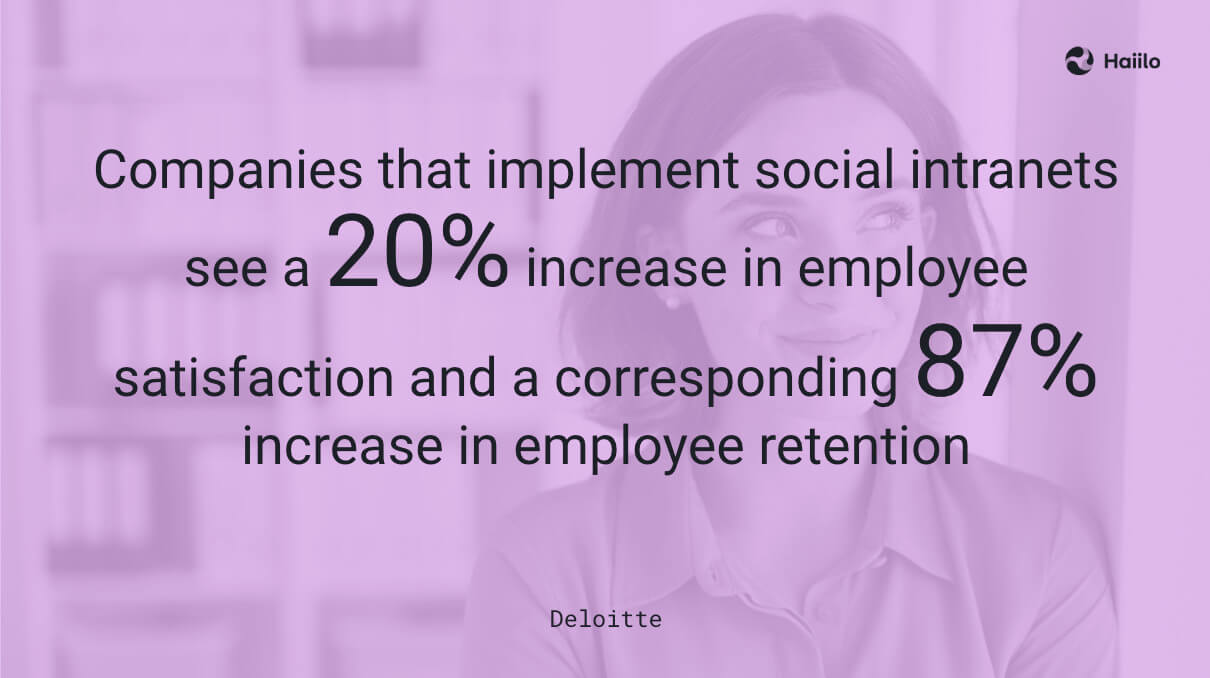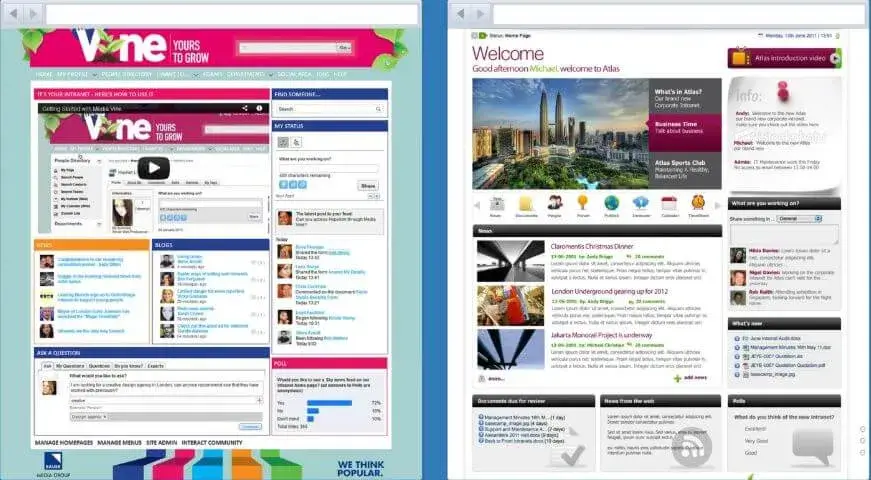Employee intranets have a long history in the workplace tech world. However, today’s intranets have very different purposes, features, functionalities, looks, and feels than they used to have.
According to Ragan, more than 50% of high-performing organizations regularly invest in new tools to improve communications. Intranets are one of the must-have solutions in every organization’s tech stack as they significantly impact employees’ engagement and experience at work.
In this blog, we will define employee intranet, explain the benefits of intranet, and conclude with a short buyer’s guide to help you choose the right platform.
💡 Also, learn about what is an employee app and why every company needs one!
Book a Haiilo demo to see how social intranet can improve your employees’ engagement and retention!
What Is Employee Intranet
Employee intranet is a technology that most people list under the HR tech category. This is understandable, as internet platforms are designed to make people more productive and engaged at work.
A survey by Deloitte found that there was a 20% increase in employee satisfaction and a corresponding 87% increase in employee retention in organizations that implemented social intranets.

Most modern intranets serve multiple purposes; they are used for internal communications, document management, team collaboration, and knowledge sharing. The latest solutions, however, offer some additional features and functionalities as add-ons.
💡Related: What is an Employee Engagement App and Why Your Company Needs One
The History of Employee Intranet
Intranets have been on the market for decades now. Moreover, they are considered one of the oldest workplace technologies out there. Unfortunately, some big intranet providers haven’t been updating their technologies for years, which is why intranets got a reputation of non-intuitive and outdated workplace tech. Consequently, user adoption can be very low; some research shows that only 13% of employees use intranets daily.
Here is an example of an outdated intranet.

This was true until the emergence of social intranets. Unlike traditional employee intranets, social intranets mimic the social media platforms we use in our private lives. They are designed to engage the end user, connect peers in the workplace, and make work more enjoyable. According to research, 31% of baby boomers, 40% of Gen X, and 49% of millennials support social tools for collaboration.
On the admin side, they enable employers to inform the entire workforce at all times, regardless of their locations and job functions (think desk vs. deskless workers).
Here is an example of a modern social intranet.

10 Reasons to Implement a Social Employee Intranet
54% of HR leaders indicated that poor technology and/or infrastructure for remote working is the biggest barrier to effective remote working in their organization.
Intranets can eliminate some of the most significant communication barriers in the workplace! Here are the top reasons why companies implement intranets:
1. Creates positive workplace culture
Consistent, open, and frequent employee communications is critical for building trust and embedding and nurturing your company’s core values.
According to research, 50% of employees say that a lack of transparency holds their company back. And social employee intranet can go a long way in ensuring transparency in the workplace and building a positive company culture.
📹 Before we dig deeper into those benefits, check our video about the secret sauce of people-first culture.
2. Boosts employee engagement and experience at work
Workplace communication is one of the main building blocks of a positive employee experience. When employers frequently communicate with their employees, they also enjoy higher levels of trust.
According to the Edelman “Trust Barometer”, trusted employers see much higher employee engagement than those workplaces where there is no trust.
3. Improves asynchronous communications
With the emergence of remote and hybrid work, asynchronous communications have become a must. While some internal communications tools, such as instant messaging platforms, are great for synchronous communication, employee intranets are better solutions for asynchronous communications.
They help companies organize critical company information and make it easily accessible to every employee.
💡 Learn about how to improve virtual communication in your company!
4. Eliminates information overload
Advanced employee intranets are built to make information more relevant to employees. Robust segmentation features enable employers to create groups and communities with common interests, locations, job functions, and other criteria.
And such segmentation helps them deliver hyper-personalized content, drastically improving readership and engagement with the company’s content. On the other hand, it eliminates information overload, one of the biggest productivity killers in the workplace.
Based on research, 36% of managers say they suffer from poor health due to the excessive amount of information they have to process at work.
5. Drives knowledge sharing
One of the biggest benefits of employee intranet is knowledge sharing. Moreover, by using social technologies, companies can raise the productivity of knowledge workers by 20% to 25%.
Here are some of the features and functionalities you should look for if you want to improve knowledge sharing in your organization:
- Global search for fast results
- Wikis that are more than texts
- Departmental knowledge hubs
- Documents & content management
6. Encourages share of voice
Historically, information within intranets would always flow one way. Today, two-way workplace communication is a must. Employees expect to be heard, and they expect to be able to provide feedback at any time.
Social intranets should drive the share of voice in the company. The best solutions out there should have the capability of creating groups and communities where people of similar interests come together and freely express themselves.
💡 Learn about intranet best practices to get the biggest possible intranet ROI.
7. Improves employee onboarding
A study by CareerBuilder found that 36% of businesses don’t have an onboarding process for new hires. Yet, organizations with a strong onboarding process improve new hire retention by 82% and productivity by over 70%.
Furthermore, investing more in communication and engagement during the pre-boarding process can improve the onboarding experience by 83%.
Social intranets are a great way for HR professionals to structure their onboarding process and make it more intuitive for employees.
You can upload relevant content, serve onboarding videos, post onboarding feedback surveys, connect newcomers with other peers, and much more.
8. Ensures workplace safety
Employee intranet is a must if your workplace mostly consists of frontline workers. It helps companies communicate the importance of workplace safety and encourages responsible behaviors. Also, it can actually warn employees about potential hazards in a timely manner.
If your employees risk getting injured or ill at work, then a mobile-friendly intranet with push notifications is a must! Furthermore, employees should, at all times, be able to warn each other about potential hazards regardless of their locations.

Similarly, if you are looking to improve crisis communications in your company, having an appropriate workplace communications technology is a prerequisite for success.
9. Enhances organizational change
Employee intranets are essential in situations of organizational change management, such as mergers and acquisitions or digital transformation initiatives.
Implementing change within organizations requires a lot of communication as it often fails due to a lack of employee buy-in.
With proper communication tools, companies can more successfully communicate the importance of change and embed new behaviors among their people.
10. Encourages employee advocacy
Companies that communicate transparently are more likely to have brand ambassadors. Social employee intranets support ambassadorship by making company content accessible to every employee.
Some solutions even have built-in functionalities for employee advocacy where employees can share the company’s content on their social media profiles in a matter of seconds.
How to Choose the Best Employee Intranet for Your Organization
In the sea of various communication tools available on the market, it can get hard to scan through all of them, evaluate them, and choose the right solution for your company.
Before implementing or building an intranet, it’s always worthwhile to map out the communication needs your future intranet should meet as well as your target audiences. There are many employee intranets on the market that serve different purposes and are a good match for companies of different sizes. Blue-collar heavy companies with the primary goal of updating employees might benefit from top-down communication, while companies that are looking for ways to engage and retain mixed-collar workers would need features for leaving feedback, comments and building communities in addition to top-down comms. In turn, companies that look for document repositories might benefit from document management systems, such as Sharepoint.
If you are looking for a modern employee intranet that has capabilities of top-down and non-vertical communication as well as knowledge management, then make sure you evaluate all of the following:
1. Two-way communication
Many intranets today still serve as top-down communication only. Meaning companies use them to push out announcements without allowing employees to join the conversation and have social interactions.
These days are over! If your goal is to improve employee engagement with the company content, you need to involve them first.
So look for a solution that provides a way to create chats, groups, and communities where people can interact with each other and make reactions to your company’s communication campaigns.
2. Intuitive interface
The biggest reason for low intranet usage is the unintuitive interface. When evaluating different solutions, make sure that the interface is intuitive even for your multigenerational workforce.
Consider asking for a testing phase where your employees of different ages can try using the intranet.
3. Easy roll-out
Older intranets built on-premises can be very expensive and slow to roll out. On the other hand, more modern, cloud-based solutions are much easier to implement and set up.
When choosing an employee intranet for your company, consider asking for a reference similar to your company. This is a great way to find out how the roll-out looked and what to expect for your organization.
4. Integrations
In his annual report, Josh Bersin, the world’s well-known HR tech analyst, predicted that:
“the industry’s emphasis this year will be on improving the employee experience through apps that are easy to use and integrate with existing tools. This “EX layer” includes communications, surveys, case and knowledge management…”
Integrating workplace technology is, indeed, one of the primary goals for technical and non-technical professionals within organizations.
Make sure that your employee intranet integrates with Microsoft 365, Google Workspace, and other communication, document sharing, collaboration, and project management tools!

5. White labeling
The look and feel of your intranet’s interface should follow your company’s brand guidelines. This can significantly improve user engagement and develop a sense of belongingness.
So don’t forget to ask for white labeling options when choosing a social intranet.
6. Mobile app
Digital workplaces are mobile-heavy. Workplaces with blue-collar workers are mobile-dependent. Being able to use intranet on your phone seamlessly is a big advantage. This is the only way to realy make information accessible to everyone at all times.
7. Security and compliance
Security and compliance are growing challenges for many internal communications professionals. So make sure that your employee intranet is at least ISO27001-certified and GDPR-compliant.
You, as the buyer, should be the data controller within the meaning of the GDPR and decide on the purpose and means of this data.
8. User management and role-based permissions
Intranet is a workplace technology usually used by the entire workplace. However, the content within the platform can be created, managed, and approved by different roles and departments.
This is particularly true for large organizations.
When evaluating different social intranet solutions, make sure that they offer granular user-management functions and robust role-based permission features to fit your organizational structure.
9. Other built-in features
When you compare different employee intranet options, you will notice that they can have different features and functionalities. Some may have optional or built-in employee surveys and employee advocacy features. Some may have more advanced analytics than others.
In any case, think of what your company may need in the future as well. Some of the intranet features may be able to fulfill your organization’s future needs.
Download our Employee Engagement Report and learn what drives and motivates modern employees!









